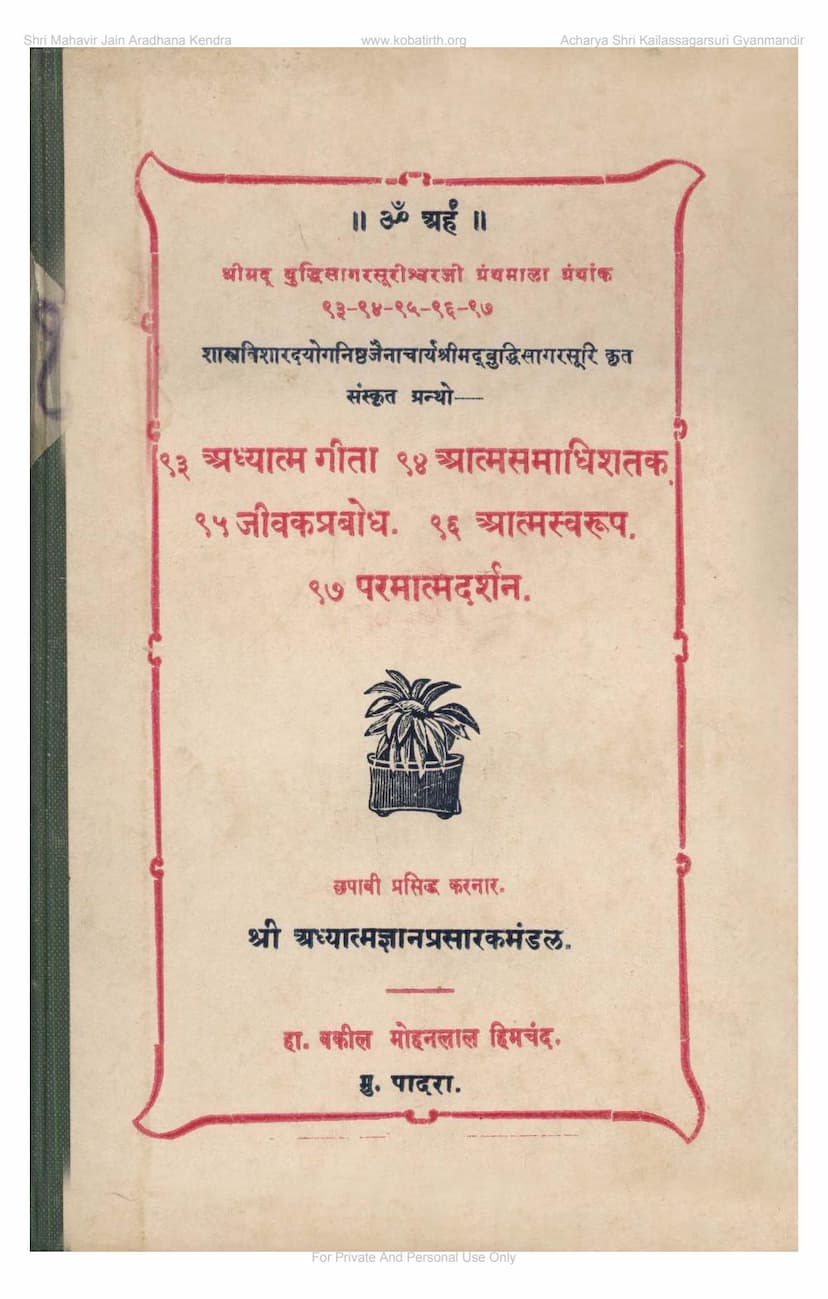Adhyatma Geeta
Added to library: September 1, 2025

Summary
Here's a comprehensive summary of the Jain text "Adhyatma Geeta" by Buddhisagar, based on the provided pages:
Book Title: Adhyatma Geeta (अध्यात्म गीता) Author: Buddhisagar (बुद्धिसगर) Publisher: Adhyatma Gyan Prasarak Mandal (अध्यात्म ज्ञान प्रसारक मंडल) Catalog Link: https://jainqq.org/explore/008502/1
This compilation, numbered 93-97 in the Shri Buddhisagar Surishwarji Granthamala, includes "Adhyatma Geeta" (93), "Atma Samadhi Shatak" (94), "Jeevak Prabodh" (95), "Atma Swaroop" (96), and "Paramatma Darshan" (97). All these works are in Sanskrit.
Origin and Context:
- The "Adhyatma Geeta" was composed by Acharya Buddhisagar Suri in Shravan Sud 10 (likely of the Vikram Samvat year 1980, as indicated by the preface detailing his travels).
- The preface describes the author's extensive travels in Gujarat in Vikram Samvat 1980, including visits to Manasa, Pethapur, Godhavi, Adalaj, Anganuj, Silaj, and Ahmedabad.
- During this period, the author faced health concerns and received a prophecy of a limited lifespan from a doctor in Mumbai. This awareness of mortality spurred him to accelerate his spiritual activities and dedicate himself to writing.
- The composition of "Adhyatma Geeta" was a direct result of this realization, aiming to focus on the pure nature of the soul.
- Following "Adhyatma Geeta," he also composed "Atma Samadhi Shatak" (on self-realization) and then translated "Jeevak Prabodh," "Atma Swaroop," and "Paramatma Darshan" into Sanskrit.
Content and Themes of Adhyatma Geeta:
The "Adhyatma Geeta" is a philosophical and spiritual work focused on self-realization, the nature of the soul, and the path to liberation (moksha). The central themes, as gleaned from the verses (Shlokas 1-529 are present), revolve around:
-
The True Nature of the Soul (Atma):
- The soul is described as inherently pure, blissful, eternal, and devoid of suffering and impurities. It is characterized as knowledge-bliss (jnana-ananda), unchanging, and the ultimate reality.
- The soul is distinct from the physical body, the senses, and the mind. Attachment to these transient elements causes suffering.
- The soul is the true self, the "I" (so'ham), and is intrinsically Brahman.
-
The Illusion of the Material World:
- The material world and its pleasures are considered illusory and the source of attachment and suffering (moha).
- Sensory experiences, worldly possessions, status, and fame are temporary and do not lead to true happiness.
- Attachment to external appearances and concepts (like name, form, reputation) is a delusion.
-
The Path to Liberation:
- Self-Awareness (Atma-upyog): Constant contemplation of the soul and its true nature is paramount.
- Detachment (Nihsanga, Vairagya): Renouncing attachment to worldly things, desires, and ego is crucial.
- Right Knowledge (Samyak Gyan): Understanding the soul's true nature and the transient nature of the material world.
- Concentration and Meditation (Dhyana, Samadhi): Focusing the mind inward on the soul leads to liberation.
- Equanimity (Samata): Maintaining equanimity in happiness and sorrow, gain and loss, and towards all beings is essential.
- Renunciation of Desires (Ichha-nirodh): Controlling and eliminating desires is key to inner peace.
- Self-Reliance: The soul is its own refuge and the source of its own liberation.
-
Critique of Worldly Pursuits:
- The text emphasizes that worldly knowledge, wealth, power, and sensory pleasures are ultimately futile without self-knowledge.
- It warns against attachment to the body and its temporary states, as well as the pursuit of fleeting worldly happiness.
-
The Role of the Guru:
- While the primary focus is on the soul's inherent nature, the preface and later verses in related texts highlight the importance of a Guru's guidance for true spiritual understanding.
Structure and Style:
- The "Adhyatma Geeta" is composed in Sanskrit verses (shlokas).
- The language is philosophical and devotional, aiming to guide the reader towards spiritual insight.
- The text uses metaphors and analogies to explain complex spiritual concepts.
Overall Purpose:
The "Adhyatma Geeta" is a profound spiritual discourse intended to awaken the reader to the eternal, blissful nature of the soul, urging them to detach from the transient material world and find lasting peace and liberation through self-realization and spiritual practice. It serves as a guide for aspiring souls seeking to understand their true identity and attain spiritual freedom.